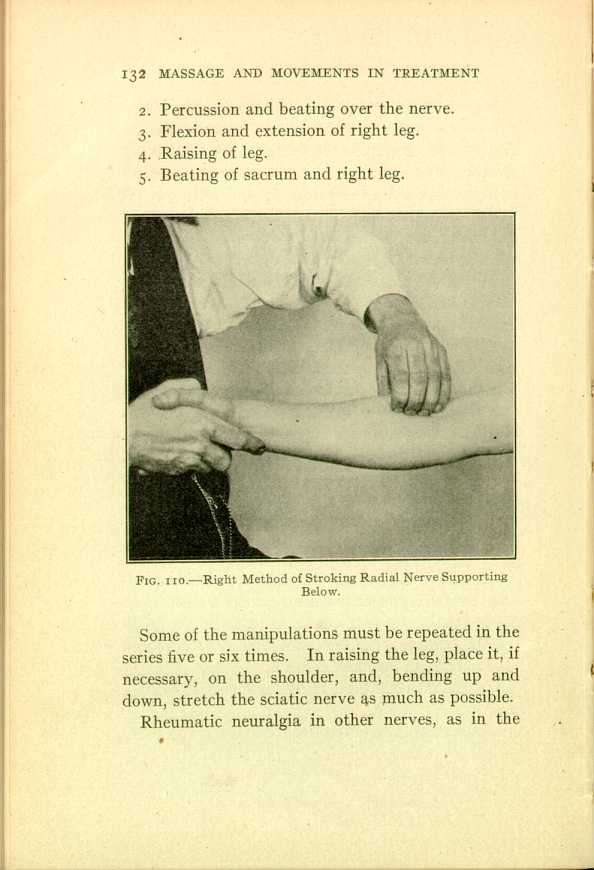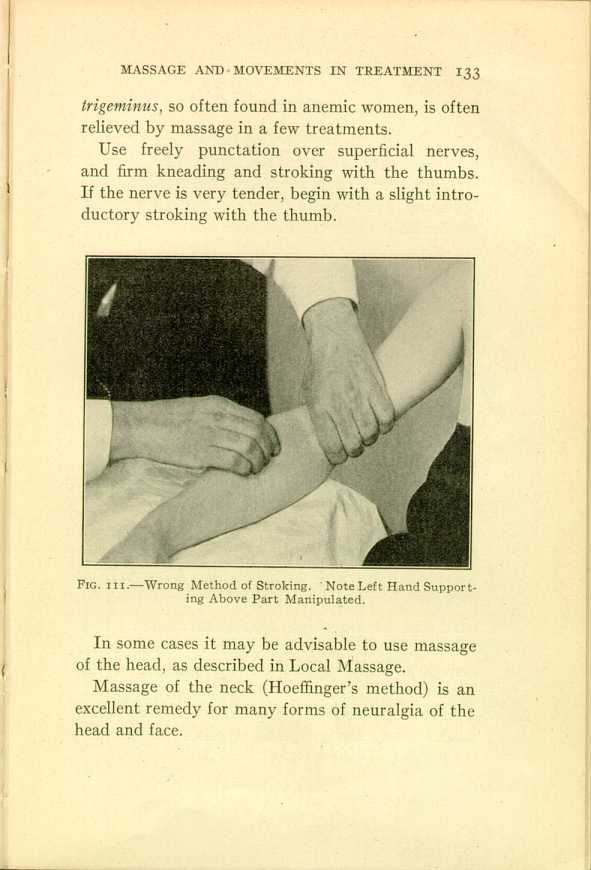| Massage and the Original Swedish Movements | ||
APPLICATION OF MASSAGE AND THE SWEDISH MOVEMENTS TO VARIOUS DISEASES OF THE BODY
The movement treatment, being an invigorating remedy, is recommended principally for chronic diseases where either the whole organism or only a part is weakened.
The prescriptions of massage and movements; given here are only mentioned in a general way the operator must use them only after a careful consideration. What may be beneficial to one individual may injure another.
The operator should consequently use such movements and manipulations as he finds suitable to the individual case, in the meantime being guided by the prescriptions here mentioned.
It is necessary in all cases to note how the patient bears each movement. If any are too strong, they must be omitted, only to be resumed as the patient's strength increases.
During the first treatments great care should be taken not to overtax the patient's strength; it is always better to do too little than too much—the one is much easier remedied than the other.
GENERAL WEAKNESS
Apply general massage. Follow with passive flexions and extensions, rotations and pressings. Finally give percussion of the back, if the patient's strength permits.
The first treatments should last from twenty to thirty-five minutes, gradually increasing t o an hour at the end of the first week. Daily treatments are often necessary.
Under this heading come most of the affections or rather conditions treated by general massage; for instance, when a patient is convalescent after fevers (typhoid, scarlatina), after operations, when the body is emaciated, in many conditions of nervous disorders, and in general when we propose the treatment as a tonic instead of outdoor exercise.
ANEMIA
For this disease some authors recommend general massage of the whole body, others recommend a complete series of movements. A series of well selected movements in connection with the general massage will perhaps be the most effective agent in renewing the blood. The treatment must be only by passive movements, and such as will aid the digestion, the circulation and the respiration.
When the patient is very feeble, use only the general massage, gradually commencing with the movements as the strength increases. All exercises should be passive, so as not to overtax the patient.
The following series, recommended by Professor Hartelius of Stockholm, Sweden, has frequently been used with success:
- 1. S rotation of the arms.[1]
- 2. Half L. rotation of feet.
- 3. Massage of abdomen.
- 4. S. rotation of arms.
- 5. S. rotation of body.
- 6. Half L. flexion and extension of legs.
- 7. St. percussion of back.[2]
The first movement is for respiration, extending the chest. The air is inspired more freely and a greater quantity of oxygen brought in contact with the blood. Eight to twelve times. The second carries the blood to the feet, which are generally cold; the third aids digestion and increases the appetite; the fourth, see 1; the fifth affects the great venous system; the sixth increases circulation in the lower extremities; the seventh has a refreshing action on the whole system.
The movements are scientifically arranged to remove the tired feeling, the loss of appetite, the cold hands and feet, the backache, and all symptoms we find in an anemic patient.
If there be any abdominal affections, special attention must be paid to them in the selection of the movements.
HYSTERIA
For hysteria we use such manipulations as will act directly upon the peripheric nervous system. The general massage, followed by a few rotary movements of the extremities, is to be recommended.
CHOREA
If the disease has advanced so far that the child has no control whatever over the limbs, place him on a couch or bed, one operator standing at the head, holding the arms, another standing at the feet, grasping the lower extremities. Begin with gentle stroking with the palm of the hand over the extremities and the chest, gradually increasing the strength; then turn the patient over on his face, and continue the firm stroking over the back and neck. The full treatment should last an hour, and be repeated daily four or five times. (Blaché.) As soon as improvement is visible, begin with certain passive movements, such as flexion and extension of the extremities, separating and closing of the knees, bending of the head, depression and elevation of the arms.
The patient is soon able to take duplicated active movements, and is finally instructed in general active movements or calisthenics, the operator keeping exact time.
Strong, persistent treatment every day, with special attention to the duplicated active movements,
—Functional spasm often yields to persistent massage treatment whereas hysterical spasm offers more resistance.—[Editor.]
PLETHORA
In this affection we use movements such as will attract the blood from the head and produce muscular activity.
The most important part of our treatment is the massage of the neck and head. By the former we can relieve the blood-pressure on the brain to a remarkable extent, the patient often after the treatment telling us: "How much lighter my head feels.'' Both methods of massage of the neck may be used, but that of Hoeffinger should be selected as the introductory massage, to reach the deeper veins and give an outlet for the congested circulation.
- 1. Massage of neck and head.
- 2. Half L. rotation of leg.
- 3. S. rotation of body.
- 4. Half L. rotation of feet.
- 5. S. rotation of head.
- 6. Kn. turning of body.
- 7. Beating of sacrum.
- 8. S. rotation of arms.
- 9. S. percussion of head, with shaking and stroking.
INSOMNIA
There are certain movements which so affect the central or the sympathetic nerve-system that they are called by some authors "sleeping-movements;''
As a rule, the general active movements are sufficient. The treatment should always be applied at bedtime. The following manipulations and treatments will prove beneficial:
- 1. Light general massage.
- 2. S. Depression and elevation of arms.
- 3. Half L. flexion and extension of legs.
- 4. S. turning of body.
- 5. Separating and closing of arms.
- 6. L. raising of body.
- 7. St. bending of knees.
- 8. Massage of neck and head.
- 9. Head clapping and stroking.
HEADACHES
During the past few years the author has had such exceptional results in the treatment of peripheral headaches that he wishes to pay some special attention to their treatment by massage. It has been clearly established that many cases of headaches with negative eye-conditions have been cured by thorough massage of the neck and head. Dr. Gustaf Norström has shown us in his excellent little book on headaches, that many of these cases are caused by myositic deposits in the neck, generally in the nape, but frequently also in the respective anatomical extremes of the neck. This may seem rather strange to many, but the trained masseur knows and almost daily experiences the fact that the
The cases are readily defined; the oculist reports that there is no condition of the eyes that could possibly cause the suffering. Then let us carefully examine the neck and head. The first thing to look for is this: is there a cerebral congestion of some standing? Hoeffinger's method of massage of the neck will tell us that. We as a rule find this congestion, particularly in the plethorics who have obstructions to the circulation in the upper part of the trunk. In the nape of the neck we find many lumps or myositic deposits, which in contradistinction to the ganglia and lymphatic glands are movable only with the particular muscle of which they form a part. Pressing of a myositic deposit will cause acute pain, often extending to the supraorbital nerve and eyelid of the corresponding side. These deposits may be recognized in three stages or degrees (Norström): we may have a swelling only, or a resistive touch, or an actual induration where the consistency is very hard and the deposit consequently well defined.
Now to the practical application of masssage for headaches. First of all we must give strong, thorough strokings with both hands from the base of the skull to the acromion processes. This is our introductory massage to relieve not only the cerebral congestion, but also the pronounced congestion of the nape of the neck. The first few treatments should
It is not sufficient to massage the muscles and their deposits only but the nerves of the scalp and of the forehead should receive attention, particularly in those cases where we are able to find local structural changes.
In regard to the Swedish movements we have principally the following as the most useful:
- 1. Susp. bending of head (concentric).
- 2. Sitting bending of head.
- 3. St. bending of turned body sideways.
- 4. Sitting turning of the head.
- 5. Ostrom's combined resp. movement (see page 96).
In the movements marked 3 and 5 the reader will notice that the author wishes to act upon the organs of the trunk which are apt to become congested, especially the liver. I have had several cases of
It is well to mention that in all cases the author has watched and treated, there was invariably either a history of gout, rheumatism or a congested liver with distended gall-bladder. Consequently we must not lose sight of the necessity of proper diet and medication to prevent the further formation of deposits— massage is effective only for what has been formed by impaired digestion and stored up in the muscles by locally impaired circulation.
APOPLEXY
Experience shows that even old cases of paralysis are very often improved, and sometimes completely cured, by mechanotherapy. Its advantages consist in being able to work upon the entire nerve-system as soon as the least activity is apparent in the affected side.
The massage is used at first to stimulate the nerves and to increase nutrition. It will always be of some benefit, provided the system has power to react.
In treating a case of paralysis the operator should remember two special points:
1. Find out which muscles are affected and treat them and their nerve-supplies with massage.
2. Overcome the contraction of the antagonists by movements, or if necessary by braces.
Where there is active power in the affected side,
- 1. S. rotation of arms.
- 2. Half L. rotation of legs.
- 3. S. rotation of right shoulder.
- 4. Flexion and extension of right leg.
- 5. Depression and elevation of right arm.
- 6. Pressing and shaking of right leg.
- 7. Pressing and shaking of right arm.
- 8. Percussion of back.
It is generally the best plan not to start the massage until three weeks after the stroke. The operator should always remember to select such manipulations and movements as will prevent a rush of blood to the cerebrum.
Paralysis from accident, gout or rheumatism, is very often treated by massage, the result depending upon the condition of the affected nerves. When caused by poison, mechanotherapy is recommended principally as a stimulating remedy, when the patient is convalescent. In paralysis from lead-poisoning massage is an excellent remedy.
The necessity of a knowledge of anatomy on the part of the operator is more apparent in treating cases of paralysis than any others. Careful attention should be paid to the facial muscles if required.
In a Swedish journal is recorded a case of an eighteen-year-old patient paralyzed in one leg from childhood. He was treated twice daily for three consecutive years by thorough massage and movements, and
It is astonishing what the inunction of cod-liver oil in connection with the massage will do in some cases of paralysis.
—Recent experiments in the treatment of cerebral paralysis have advanced the theory, that by immobilization of corresponding unaffected muscles, the paralyzed ones quicker regain normal function.—[Editor.]
INFANTILE PARALYSIS
In this obscure and troublesome affection scientific massage has won some of its greatest victories. With the aid of the electric current we first find out which muscles or which groups of muscles are affected. This should not be done however until one full month from the day of the first attack. It is a well acknowledged fact that the amount of damage done to the tissues will all depend upon how soon the disease is properly recognized, so as to promptly apply the counter irritation to both sides of the whole spinal column.
When we begin the massage we should give strokings only over the whole affected limb to increase nutrition and tone up the different parts, but the deep massage should at first be given only to the most affected muscles and their nerve supply, the other or stronger groups being severely let alone. In my own practice I have often taken cases of this
We stretch the spinal column by movements or better still by suspension as the patient gains strength and I always arrange a horizontal bar with cleats in a doorway so that I have two heights, one for the child sitting and one for the standing position. When the braces are first put on I use a double bar fitting the height of the child like a crutch; there is also another cross-bar below to put the hands on; the uprights are slanting inward and only room enough is given for the child to get through. This is an excellent arrangement in the early starting of teaching coordination. My next move is generally to let the child push the rolling chair, if old enough; by this time there is more coordination, he will begin to balance at first for a minute, then more and more every day; now we may begin with crutches cut rather short so as to get a slight forward bend which helps to steady the patient in balancing; then only one crutch and a cane and finally the one cane. Of course it will be understood that in the meantime the child has medical tonic treatment also electricity and hydrotherapy in connection with the massage. The treatment must be given every day if there is to be any result expected.
The movements which I use are principally for the spine as Lying raising of the body. At first it is often necessary to tie a sheet around the foot-board of the bed and have the patient try to pull himself up or it may be necessary for the operator or the mother who should be taught how to give these movements, to assist the child by placing the hand between the shoulder blades. Suspension, passive and active we have already discussed. Now in regard to the movements for the extremities used in connection with our massage we will take a fairly typical leg for demonstration: the foot is constantly extended, hence we flex the foot (much easier done if the leg is flexed at the same time) to overcome the contraction of the extensors. The foot is not only extended but also everted; consequently we invert it with our flexion. The same child can draw her leg up but can not possibly push it down or in any way extend it, hence we practice extension of the leg; the right leg she can bring in to the median line hence her adductors of the right side are saved, but she lacks power of rotation outward so we give that movement to act upon the biceps femoris
On account of the excellent results that the author has had in treating this affection, it has frequently been suggested that he had some new, secret methods of treatment, but such is not the case and any intelligent and qualified operator will by following the above instructions have the same good results. It should also be mentioned that I frequently make use of exercises similar to those described by Fraenkel to help along coordination. On a board I draw two large, round points connected with a line and make the child learn to follow this; afterwards I make a triangle in the same way and later a semi-circle or an ellipse. I have found these simple exercises of great practical value.
TABES
Apply massage of the back in connection with pressing. Massage of the abdomen, with pressing above the bladder and pressing and shaking of the extremities, are frequently used. Some authors recommend extension of the legs, pulling of the legs and beating of the sacrum. The movements should be refreshing and invigorating and great care should be taken not to overexert the patient.
A rest in bed for six weeks with intelligently applied massage and inunctions, if indicated, have
Of all movements recommended by the authors on mechanotherapeutics in the treatment of locomotor ataxia none equals the pulling of the legs. Place the patient perfectly flat on his back without head-rest; grasp with one hand around the ankle, with the other firmly above the knee—pulling downward slowly without jerking. Carefully and properly applied, this simple movement will often relieve the most agonizing ataxic pains.
As trained nurses are often requested by the attending physician to inunct a patient with blue ointment in this affection, and as the author has seen several cases in which the "inunction'' consisted of merely placing the prescribed quantity in the groin or axilla, he considers it proper to here give the correct method of inunction as recommended by Dr. Sigmund. The patient should, if possible, take a hot bath as a preparation. If that, for some reason, be impossible, it becomes the operator's duty to wash the part inuncted, either with soap and warm water or with alcohol and water, to dissolve the fat in the pores. The ointment should be worked in with moderate friction by the palm of the hand: on the first day on the inside of the legs; on the second day on the outside of the thighs; on the third day on the sides of the trunk; on the fourth day on the back; on the fifth day on the inside of the arms; on the sixth day commence a new series. In twenty to
The new preparation "Mercury-Vasogen'' is now generally used for inunction and it is far superior to the blue ointment as it works in so much quicker and does not leave a disagreeable odor. Besides it has been the author's experience that it does not produce any skin-affections, while the blue ointment is very apt to cause not only local irritations of the parts inuncted, but also eczema and erythema.
NEURALGIA
Diseases of the peripheric nerves are more successfully treated by mechanotherapy than are affections of the central nerve-system. Most neuralgias yield readily to massage, and in cases of sciatica it has been used with most excellent results.
For the latter disease, if the right leg is affected, use:
- 1. Stroking of right leg (from behind).
132
- 2. Percussion and beating over the nerve.
- 3. Flexion and extension of right leg.
- 4. Raising of leg.
- 5. Beating of sacrum and right leg.
Some of the manipulations must be repeated in the series five or six times. In raising the leg, place it, if necessary, on the shoulder, and, bending up and down, stretch the sciatic nerve as much as possible.
Rheumatic neuralgia in other nerves, as in the
Use freely punctation over superficial nerves, and firm kneading and stroking with the thumbs. If the nerve is very tender, begin with a slight introductory stroking with the thumb.
In some cases it may be advisable to use massage of the head, as described in Local Massage.
Massage of the neck (Hoeffinger's method) is an excellent remedy for many forms of neuralgia of the head and face.
NEURITIS
Neuritis is an inflammation of the nerve-trunks
with pain, specially intensified by pressure. Gentle
massage in the form of strokings is indicated from the
beginning. In a case of neuritis of the arm we treat
the brachial plexus carefully and stroke gently upward
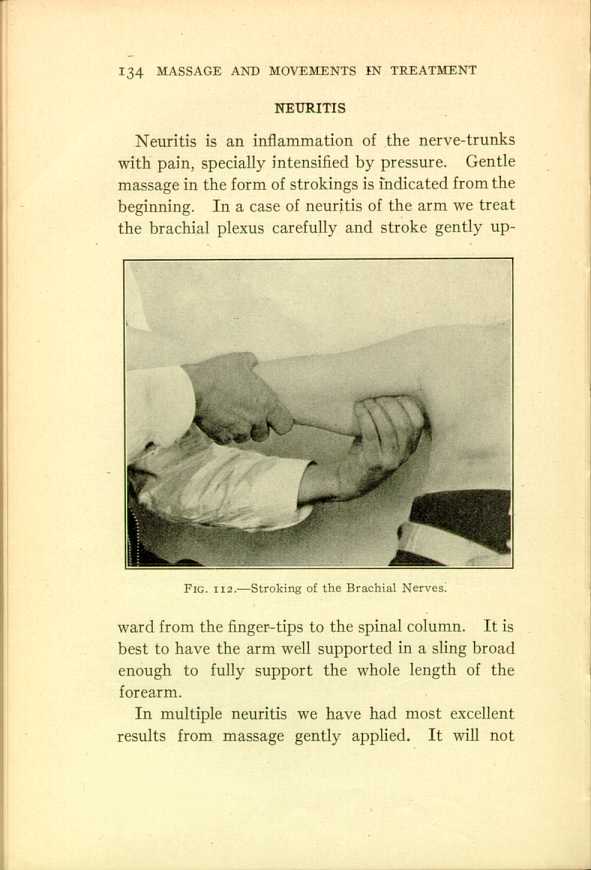
FIG. 112.—Stroking of the Brachial Nerves.
[Description:
Photograph of an operator's hand stroking a patient's upper arm.
]
In multiple neuritis we have had most excellent results from massage gently applied. It will not
The author favored the use of "Eucalyptus liniment'' from which he claimed good results. Rub the affected part with
| Oil of Eucalyptus | 1 oz. |
| Camphor Petrogen (Wyeth) | 2 oz. |
PROGRESSIVE MUSCULAR ATROPHY
Use massage in the neighborhood of the affected muscles and upon them, and such movements as are calculated to increase circulation through the diseased parts.
Suppose a case of atrophy in the deltoid and supraspinatus; the following treatment should be used:
- 1. Massage of the arm from the fingers up to the trapezius.
- 2. Rotation of the hand.
- 3. Flexion and extension of the arm.
- 4. Rotation of the shoulder.
136
- 5. Firm hacking or clapping upon the whole arm, and especially around the shoulder.
- 6. Vibrations over brachial plexus.
WRITERS' CRAMP
Use massage from the tips of the fingers to the shoulder. Rotation, turning, flexion, and extension of the hand and arm may be used as the patient grows stronger, but massage is the principal part of the treatment.
The operator must be careful not to overtax his patient's strength. In beginning only treat the hand and forearm from ten to fifteen minutes.
—The prognosis in trade neurosis is not particularly good, but I think it is most generally accepted, that massage and movements are the most effective means, and should at least be given a fair trial.—[Editor.]
SPLANCHNIC NEURASTHENIA
So important has this functional disturbance lately become in this country that it is high time that its proper mechanical treatment be analyzed. As Dr. Abrams so clearly puts it, the principal symptoms are: "Abdominal sensitiveness, tenderness of the liver and enlargement of that organ and gaseous accumulation in the bowels.''
In regard to the treatment we have to remember that physiologists have proven to us the fact that
We begin with massage of the liver, so as to give the venous circulation a free outlet. The patient is lying on his left side with the right arm over his head and the operator carefully works over the whole hepatic region not forgetting the three splanchnic nerves. Many "paths and—practics'' would have you believe that they are the only ones who pay proper attention to organic nerve-supply, but it is not true. Fortunately we possess the plain writing of P. H. Ling and his true pupils published almost one hundred years ago to conclusively prove that the Swedish mechanical operator, or medical gymnast who is properly trained always is taught to attend to the nerve-supply of the individual organ or muscle that he may be treating. The massage of the abdomen in general is now given so as to improve the muscular tone and overcome the local congestion. Massage of the neck is also given.
As we gain ground we instruct the patient in some of those Swedish movements which compress the viscera and tone up the whole abdomen. Other-therapeutics in the shape of electricity and hot-cold sponge baths are most effective, and the reader who is specially interested in the rational
AFFECTIONS OF THE RESPIRATORY ORGANS
Respiration is altogether mechanical, depending upon the constitution of the muscles of the chest, the extension of the latter, and the quantity of air inspired. If the capacity of the lungs be increased, all difficulty of breathing, coughs, etc., caused by an imperfect respiration, will soon disappear.
In cases where defective respiration is the result of weakness of the respiratory muscles or of deformities of the chest, the movements have proved the best means for increasing the capacity of the respiratory organs (see page 96).
The effect of the medical gymnastics is to necessitate frequent and deep inspirations, and more complete expiration, thus increasing the capacity of the lungs, promoting pulmonary circulation and causing an increased oxygenation of the venous blood.
CATARRH OF THE LUNGS
Certain manipulations (hacking, clapping and shaking) on the chest have been used to induce expectoration. The movements must be such as to cause muscular activity and increase the secretion from the skin. Action upon the digestive organs will produce a derivative effect upon the lungs.
PHARYNGITIS AND LARYNGITIS
Because massage of the neck and throat induces such an evacuation of the blood-vessels, it has been freely used for acute catarrh of the pharynx, trachea and nose. We are able by careful examination of the inflamed mucous membranes, before and after the application of massage, to notice directly the result. Not the local symptoms only, but the headache, the pain in the forehead, the dizziness, etc., resulting from the stagnation of blood, disappear after a few treatments. By massage we also act upon the tonsils and other glands, thus assisting expectoration.
Croup may sometimes be speedily relieved. Weiss has noted a case of croup in which a single application removed the most imminent peril.
The massage of the neck and throat ought to be more freely used for these affections.
CONSUMPTION
Some respiratory movements are used to make the patient more comfortable, increasing the inspiration and assisting the heart in its action.
Massage of the lower extremities is sometimes applied to relieve the swelling and to increase the circulation.
General massage is often recommended as a tonic, but should always be given in the forenoon, and never at night, as it has then a decided tendency to increase the night sweats.
BRONCHITIS, NERVOUS ASTHMA, ETC.,
are frequently treated by massage, generally in the form of strokings of the entire chest, the patient inspiring deeply at the same time. The séance must not exceed twenty minutes.
COLDS
So many persons suffer with recurrent colds in our changeable climate that we deem it well to pay some attention to the matter. A cold is an inflammation of the mucous membrane lining the upper respiratory passages. One region is generally more affected than the others. A cold begins with a congestion and its principal causes are: (1) "chilling the skin in a person whose skin is sensitive and tender to the changes of temperature, causing a contraction of the superficial blood-vessels, and driving an excess of blood to the deeper structures of the body; (2) local irritation to an already congested respiratory tract, by the inhalation of polluted air, and air containing irritating substances such as dust, smoke, gases, etc.''
Colds are most common in winter time, not on account of the cold weather but because at that time we breathe the most impure air, everything often being shut up in order to keep warm.
To prevent colds we must consequently breathe pure air and keep the function of the skin normal. This latter is best accomplished by proper daily
If the patient has the opportunity of scientific massage for half an hour each morning so much the better; if not we must teach him some few effective movements to be practiced every morning after his bath. The following are good:
- 1. Standing rotation of arms.
- 2. Ostrom's combined resp. movement.
- 3. St. bending of the body forward and backward.
- 4. Deep knee bend.
- 5. St. bending of the body sideways.
We do not wish the reader to lose sight of the fact that there are certain remedies which, if taken in the very incipiency of a cold, are really specific in their effect.
DISEASES OF THE HEART
Massage and movements are indicated in affections of the heart caused by nervous debility, anemia, diseases of the stomach, etc. The movements mostly used are:
Sitting, raising of the chest, with shaking, to produce strong respiration;
Rotation of the extremities, to assist the heart in its action;
Rotation and turning of the body, to give effect upon the great venous system;
Centripetal stroking, to remove the subcutaneous effusions.
In organic diseases of the heart, movements are recommended by some of the most eminent physicians. They apply movements to support the heart in its action, generally using such as will increase the circulation in the distant parts of the body.
Within the last few years a new system of exercise for heart-affections has been developed by Dr. August Schott, of Bad Nauheim, Germany. The results have at times been remarkable. He employs the effervescent Nauheim water, as a rule daily, and directs a series of resistive exercises (original Swedish movements) to be given daily, or every other day if the patient is too weak. The general massage— gently applied—is too often lost sight of as a most excellent preparation for this particular movement cure. All the movements are duplicated-active,
- 1. Intermission of the pulse.
- 2. Weakness of the pulse.
- 3. Increased respiration.
- 4. Palpitation of the heart.
- 5. Dilatation of the nostrils.
- 6. General feeling of discomfort.
When any of the above-mentioned symptoms appear allow a few minutes' rest; or, if necessary, stop the treatment for the day. It is customary to take the pulse and respiration before starting, during the middle of the séance, and at its close. A careful record should be kept for the reference of the attending physician.
The principal Schott exercises are:
- 1. Separating and closing of arms.
- 2. Flexion and extension of arms.
- 3. Raising of the arms upward.
- 4. Rotation of the arms.
- 5. Pronation and supination of the forearm.
144
- 6. Flexion and extension of the hand.
- 7. Flexion and extension of the fingers.
- 8. Abduction and adduction of the fingers.
- 9. St. bending of the body forward and backward.
- 10. S. bending of the body sideways.
- 11. S. rotation of the body.
- 12. Same as 1, with clenched fist.
- 13. Same as 2, with clenched fist.
- 14. St. arms extended forward and backward.
- 15. L. flexion and extension of the leg.
- 16. L. flexion and extension of the foot.
- 17. L. separation and closing of the thighs or legs.
- 18. St. leg extended forward and backward.
Careful operators are sometimes requested to apply treatment locally; then use massage of the chest, as previously described, with hacking in small circles over the cardiac region. Palmar vibrations are also used. In the European institutes of medical gymnastics it is quite common to see the vibrations applied over the heart. The operator then places his arm upon the artificial vibrator and the wave-like movements are transferred to the cardiac region through the semi-flexed and abducted fingers. Except when especially requested by a physician, however, this local application is seldom used. Gentle respiratory movements should always form the conclusion of the treatment, and an hour's rest should be rigidly insisted upon.
DISEASES OF THE DIGESTIVE ORGANS
In applying mechanotherapy for these affections, we must call attention to the fact that most of them develop from circulatory disturbances, the vessels being relaxed.
There are different ways to apply massage of the stomach; one has already been described. Another way is to place the fingers about two inches below the ribs and, with pressing, move the hand upward in connection with shaking. In a special position (half lying, with the knees flexed, so as to relax the abdominal muscles, crook-half-lying) it is quite easy to reach the stomach by pressing, shaking and kneading.
Massage of the stomach is indicated in all affections caused by circulatory disturbances or general weakness (atony) of the parts.
DYSPEPSIA
- 1. Massage of the stomach and the abdomen (fifteen minutes).
- 2. Percussion of the back.
- 3. High St. pulling of legs.
- 4. S. turning of body.
- 5. Flexion and extension of legs.
- 6. S. rotation of arms.
- The movements are repeated.
HABITUAL CONSTIPATION
Massage and movements are now freely used for constipation. The treatment must always be local in the beginning, and afterward constitutional.
- 1. Local massage (ten to twenty minutes).
- 2. St. bending of knees (hands on hips).
- 3. L. raising body.
- 4. S. turning of body.
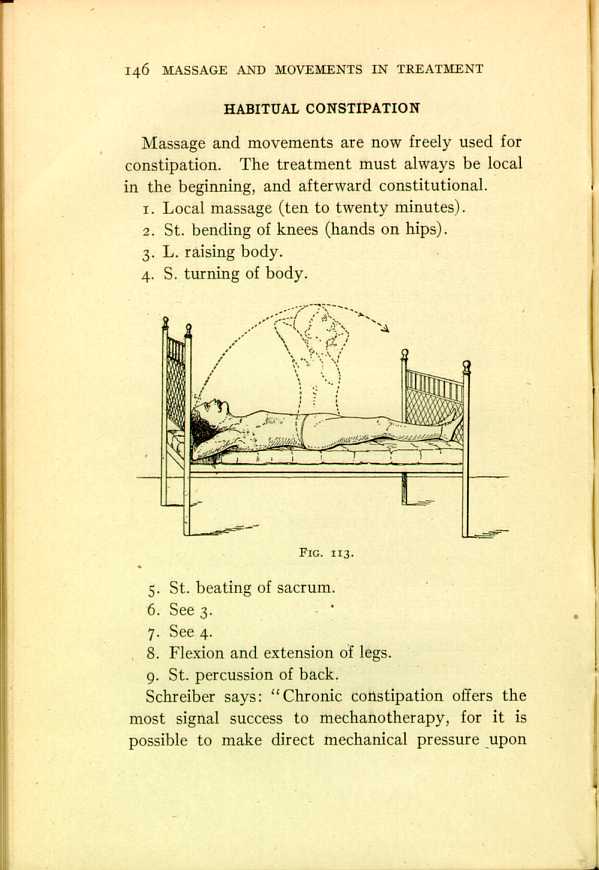
FIG. 113.
[Description: Drawing of a man lying on a bed. Dotted lines indicate movement to a sitting position. ] - 5. St. beating of sacrum.
- 6. See 3.
- 7. See 4,
- 8. Flexion and extension of legs.
- 9. St. percussion of back.
Schreiber says: "Chronic constipation offers the most signal success to mechanotherapy, for it is possible to make direct mechanical pressure upon
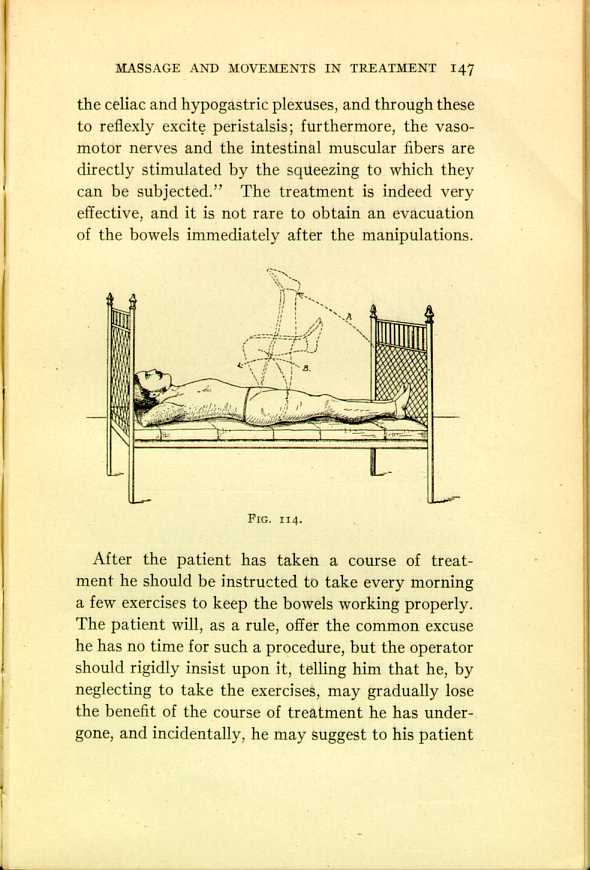
FIG. 114.
[Description: Drawing of a man lying on a bed. Dotted lines indicate movement of the legs. ]After the patient has taken a course of treatment he should be instructed to take every morning a few exercises to keep the bowels working properly. The patient will, as a rule, offer the common excuse he has no time for such a procedure, but the operator should rigidly insist upon it, telling him that he, by neglecting to take the exercises, may gradually lose the benefit of the course of treatment he has undergone, and incidentally, he may suggest to his patient
As in Fig. 113, the patient should lie flat on his back, without
head-rest, with hands clasped back of the head; he should slowly rise to
a sitting position,
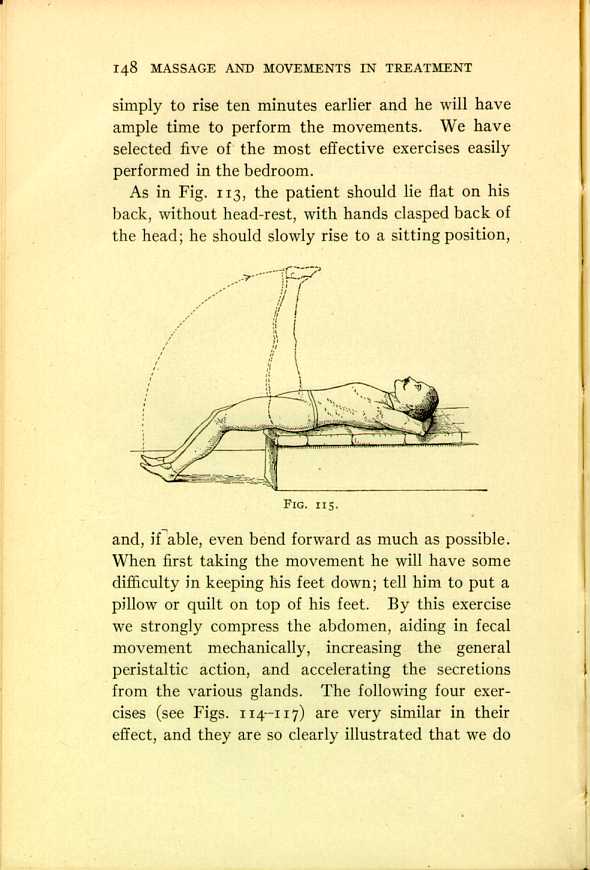
FIG. 115.
[Description:
Drawing of a man lying on a platform. Dotted lines indicate movement of the
legs.
]
Constipation is of most frequent occurrence in infancy. Less than three
evacuations a day indicate a constipated condition. Place the child flat
on its back in the bed, or, if convenient, on the
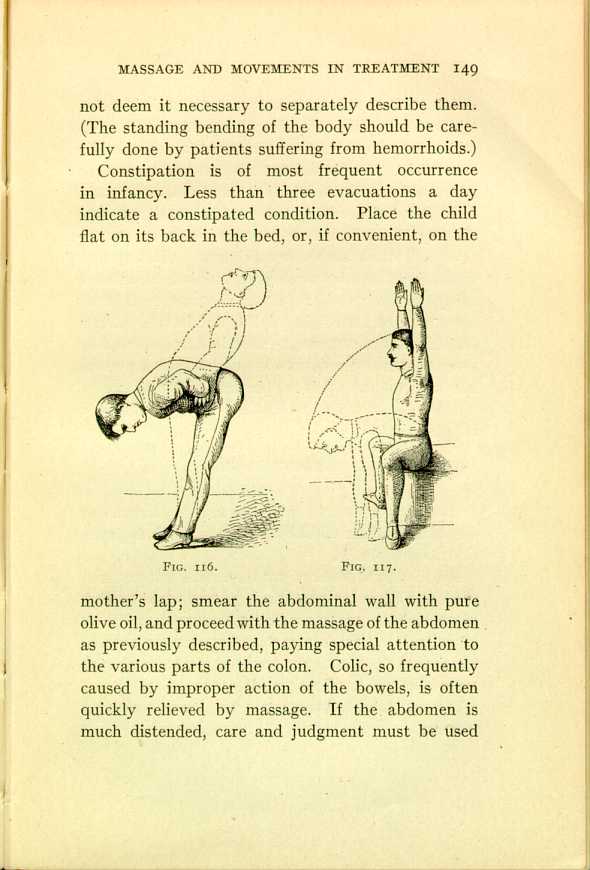
FIG. 116.
[Description:
Drawing of a man bent at the waist. Dotted lines indicate movement.
]
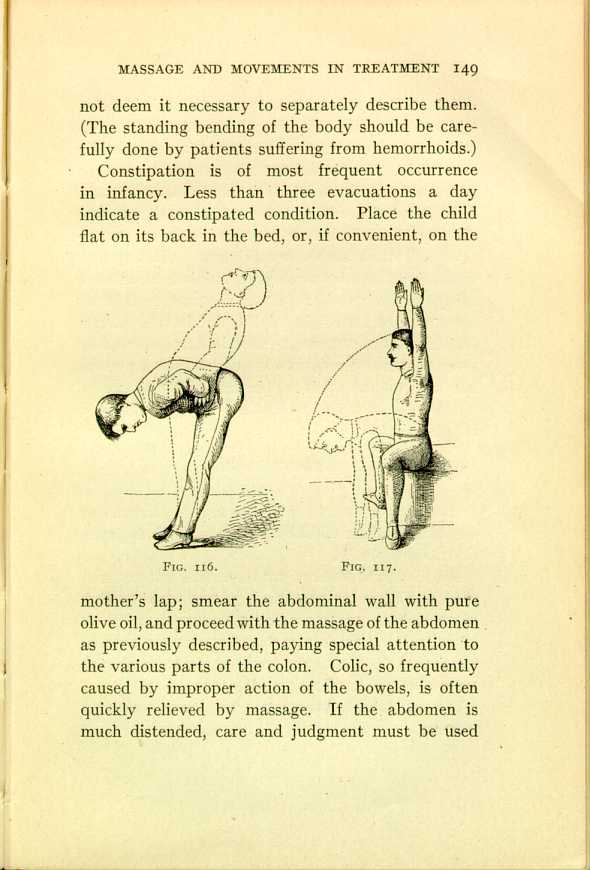
FIG. 117.
[Description:
Drawing of a seated man with his arms extended. Dotted lines indicate movement.
]
—A child responds readily to manual treatment; more so than a grown person, but unfortunately this simple and effective remedy is seldom resorted to until other therapeutics have failed.—[Editor.]
HEMORRHOIDS
Closely connected with the former disease is the accumulation of blood in the abdominal parts, called hemorrhoids.
By the manipulations on the abdomen we assist the intestines in their action; by rotation and turning of the body we control the great venous system, and by beating over the sacral region we increase the circulation in the region of the rectum relieving congestion in the Hemorrhoidal vein.
The following movements have been used with success:
- 1. Massage of the liver and the abdomen (ten to fifteen minutes). See page 21.
- 2. St. bending of knees.
- 3. Separating and closing of knees.
- 4. L. raising of body.
- 5. Rotation of legs.
- 6. Beating of sacrum.
- 7. Rotation and turning of body.
Although we highly recommend the movements for this affection, we must acknowledge that one treatment a day is not enough. The patient must be instructed in certain calisthenics which give a direct effect upon the great venous system.
OBESITY
Massage and Swedish movements have been used with great success in cases of obesity. Muscular exercise decreases the fat by promoting a more perfect oxygenation through the whole organism.
In connection with firm massage use the following movements:
- 1. Separating and closing of arms.
- 2. Separating and closing of legs.
- 3. L. raising of body.
- 4. St. bending of knees.
- 5. St. rotation of arms (active).
- 6. St. turning of body.
During the first treatments use only a few movements, gradually getting the patient used to them.
Without proper diet massage will accomplish but very little.
Frequently the masseur will be asked by the patient how he can consistently claim that massage will reduce fat, and also in a thin person produce fat. When we desire to reduce fat we give firm massage, especially kneading, which produces heat; this causes combustion of fat. When we apply the treatment with the object of increasing weight we do so by building up the whole system and particularly the digestive organs. Whatever our aim may be, one of the most important parts of the treatment consists in teaching the patients how to breathe properly.
ENLARGEMENT OF THE LIVER
We use movements, that are calculated to increase the circulation through the great venous system.
- 1. S. rotation of arms.
- 2. L. rotation of feet.
- 3. S. raising of body.
- 4. L. rotation of legs.
- 5. S. rotation of body.
- 6. St. flexion and extension of feet.
- 7. Massage of the liver with clapping.
- 8. Separating and closing of knees.
153
- 9. Vibrations over the liver.
- 10. St. percussion of back.
The movements must be performed twice a day, and the patient instructed in certain calisthenics.
DIABETES
Some authors report cases of diabetes successfully treated by mechanotherapy. Schreiber says: "The best effects will ensue when the greatest number of muscles are brought into play. It is necessary to select such movements as will call into action equally all the great muscle-groups.''
In Paris, where diabetes is common, the patients are advised to take very strong bodily exercise. The quantity of sugar secreted must indicate a deficient oxygenation of the materials produced by the liver. Strong bodily exercise, which increases oxygenation in all the membranes of the body, ought to eliminate the abnormal presence of sugar.
The proper exercise for this affection is not yet well determined. When the patient has a constitution strong enough to bear the treatment, use the following movements:
- 1. St. percussion of back.
- 2. L. rotation of feet.
- 3. Separating and closing of arms.
- 4. S. bending of body backward.
- 5. Flexion and extension of legs.
- 6. Raising of body.
154
- 7. Flexion and extension of arms.
- 8. Separating and closing of knees.
- 9. Percussion of back.—Strong vibrations of the region of the pancreas stimulates that gland to increased secretion, the function of which is to transform sugar into glycogen.
UTERINE AFFECTIONS
Massage is applied directly to force the organs to contract, and the movements to regulate the circulation through the abdomen. Atony and dislocations of the organ are generally treated by massage; disturbances in regard to menstruation, only by movements.
AMENORRHEA
- 1. S. rotation of arms.
- 2. Rotation of feet.
- 3. S. turning of body (inspiration).
- 4. S. rotation of body.
- 5. Beating of sacrum.
- 6. Vibrations.
- 7. Rotation of arms.
- 8. St. percussion of back.
Some of the movements must be repeated several times in the series, but when treating extremely anemic women great care should be taken not to give too many.
DYSMENORRHEA
A great number of women suffer severe pain before and during the periods. In many of these cases we can by overcoming the local congestion give the greatest relief. We recommend:
- 1. Massage of the liver.
- 2. Massage of the whole abdomen.
- 3. St. rotation of arms.
- 4. L. rotation of feet.
- 5. St. rotation of body.
- 6. L. rotation of leg.
- 7. St. bending of turned body.
- 8. L. rotation of pelvis.
This treatment should be given to the patient at least two weeks before the period is expected, and she should be properly instructed how to take a few good movements to prevent the congestion of blood in the abdomen.
I have made the observation that women who lace tightly are always the greatest sufferers from dysmenorrhea.
AFFECTIONS OF THE BLADDER
We have here to deal with two common conditions: the retention of the urine and the incontinence of the urine. Both have been successfully treated by massage. Before starting the treatment the bladder should be emptied naturally, or artificially, if necessary.
Massage the whole abdomen first and then use strokings, frictions and vibrations (see page 57) locally.
In many nervous women especially at the climacteric period we find the symptom of frequent desire to urinate.
In such cases massage is an excellent remedy, vibrations being especially effective.
The bladder should never be treated mechanically except on the order of a physician, as there are many conditions in which massage may do a great deal of harm instead of good.
RHEUMATISM
The active movements, as well as pétrissage, hacking and beating of the affected parts, are of great benefit in cases of rheumatism. In severe attacks the treatment should be applied twice daily. The patient must move his limbs freely instead of keeping them inactive.
Begin with general massage around and over the affected part; continue with local massage on the diseased muscle or joint and finish the treatment with a few movements that give effect upon the circulation and respiration.
The operator should study his case carefully and by passive and active movements of the affected part try to localize the rheumatic deposits. How important this is will be clearly illustrated to the reader in the following case:
A gentlemen was sent to me for massage for a "rheumatic shoulder;'' he had been treated for some time with massage applied locally, i.e., right over and close to the joint. The result had been unsatisfactory and he had no faith in the treatment. The joint was carefully examined and was found all right. He could raise the arm and he could rotate it without pain or difficulty, but when I told him to throw the arm downward and backward, I then saw that his trouble was located in the latissimus dorsi. This muscle was then carefully treated and with very satisfactory result. He at first ridiculed the idea of curing an affected shoulder by treating the lower part of the back, but is today a very enthusiastic believer in scientific massage.
LUMBAGO
The patient should lie on his stomach with the abdomen supported by pillows. The operator should perform firm strokings with both hands over the lumbar region, from the spinal column toward the sides. In many cases it is well to give massage to the whole back and the glutei, as previously described.
The treatment must be given twice or three times daily. It generally takes from two to five days to conquer the trouble.
The following additional movements may be used:
- 1. St. bending of body.
- 2. L. raising of body.
- 3. S. bending of trunk.
- 4. S. raising of body.
- 5. Local vibration.
STIFF NECK
This affection is somewhat similar to lumbago and has been treated with like success. Begin with massage over the sterno-cleidomastoid and continue with pressing and shaking. A few (in the beginning passive) movements will finish the treatment. Though at first painful, the patient will in a few days be relieved by the treatment:
The following movements may be used:
- 1. S. or susp. bending of head.
- 2. S. turning of head.
- 3. S. rotation of head.
GOUT
Between the attacks massage is often prescribed especially for podagra. The treatment must be given for general activity of the muscles.
- 1. St. bending of knees.
- 2. St. bending backward (back supported).
- 3. L. flexion and extension of legs.
- 4. S. turning of body.
- 5. S. rotation of arms.
- 6. Flexion and extension of feet.
159
- 7. S. raising of body.
- 8. Beating of sacrum.
- 9. Massage of stomach.
- 10. St. percussion of back.
The general massage is always of benefit and firm friction on the sole of the foot is very effective in cases of podagra.
Massage is of great value as a preventative of gout, as it eliminates urates and improves the general condition.—[Editor.]
LATERAL CURVATURE OF THE SPINE
There are few affections in which the movement treatment has met with more signal success than in this. The aim should be to invigorate and develop the weakened and pathologically changed muscles of the convex side so as to restore the natural equilibrium of the two sides. There are but four known and acknowledged methods of developing muscles locally—viz., massage, movements, electricity and hydropathy. As the two latter do not come within the province of this manual we shall only describe the two first mentioned.
The main things to remember in treating lateral curvature of the spine are:
- 1. To elongate the spine by suspension.
- 2. To raise the lower shoulder.
- 3. To counteract rotation of the vertebrae.
- 4. Massage to stimulate the muscles.
160
- 5. Selected movements in carefully selected positions.
Massage of the back is very useful in most all cases of scoliosis, and the operator should pay special attention to the convex side, particularly in the early stages of the affection. The treatment should be applied also to the glutei the gluteus maximus in particular. Pinching is a very valuable manipulation, and when the patient becomes used to the massage apply it firmly, so as to reach the deeper layers of muscles. In older cases, it sometimes becomes necessary to treat also the muscles of the concave side, which from disuse have become atrophied. When the primary curve is high up, the cervical region should be faithfully attended to. Patient will often complain if too much pressure is used over the extreme convexity of the compensation curve—"the abrupt lower bend,'' as some patients style it.
We give here a list of the various Swedish movements used in the treatment of lateral curvature, and the operator who has been properly trained will experience no difficulty in selecting those which will prove the most beneficial to the individual case in question.
- 1. St. Bending to the (Convex) Side.—The patient stands
with hands clasped on the back of the head. The operator places one hand
on the highest point of the curvature and the other on the opposite hip,
the patient bending slowly about ten
times. It may also be used as a single active movement.161
- 2. St. Bending to the (Convex) Side.—Same movement as 1,
only the patient places the arm
corresponding to the lower shoulder-blade over his head as demonstrated in Fig. 118, the other hand on hip. Single active or duplicated active, in the latter case the operator placing his hands as in 1.
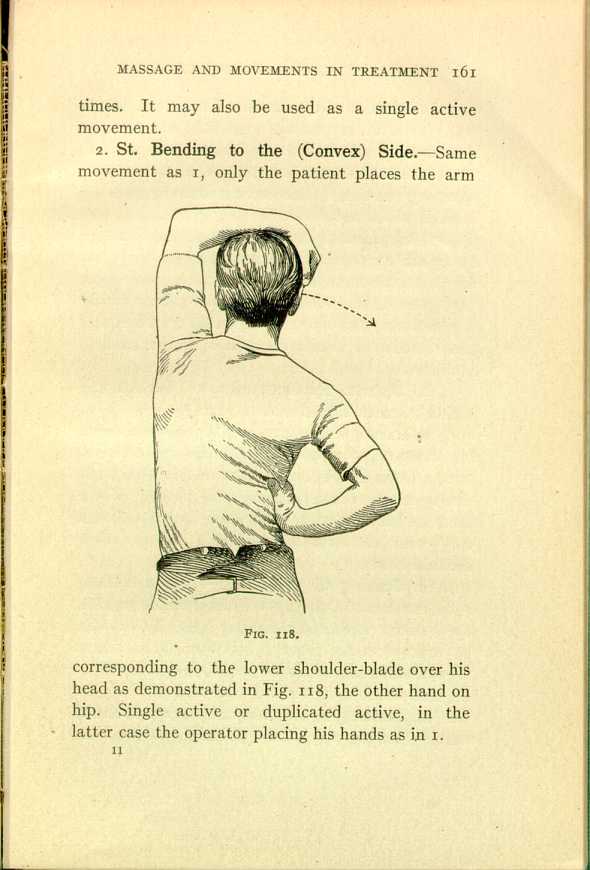
FIG. 118.
[Description: Drawing of a man from the back with his left arm curved over his head and his right hand at his waist. ]162 - 3. St. Rotation of the Arms.—The patient should stand as erect as possible with arms at sides; he should carry his arms slowly forward and upward, then backward and downward. A very useful respiratory exercise, besides acting strongly upon the muscles of the shoulders.
- 4. S. Separating and Closing of the Arms.— Described on page 85. It acts strongly upon the muscles of the chest, but also upon those of the upper part of the back. Kellgren says that if this exercise is performed with one arm at a time, correction of the rotation in lateral curvatures of the spine is produced.
- 5. St. Flexion and Extension of the Arms.— This movement is described on page 82.
- 6. St. Raising of the Arms.—The patient is standing with thighs supported; the arms are extended outward and raised upward by the patient, while the operator resists, grasping the wrists. If one shoulder-blade is much lower than the other, work only with the arm corresponding to the lower shoulder-blade.
- 7. St. Raising of the Arms.—This movement is the same as No. 6, only it is single active; that is, the patient performs it himself. He should raise his arms from the sides to above his head with a deep inhalation, afterward lower them slowly to original position, and exhale while doing so.
- 8. St. Bending of the Body Forward and Backward.—(See
Fig. 82.) The patient should place his
hands on his hips or clasp them on the back of his head. Another form of this exercise is performed in the following way: The patient stands with his limbs separated and his arms stretched straight up; he should bend slowly forward until the tips of the fingers touch the floor (see Fig. 83).163
- 9. L. Extension of the Back.—The patient is lying with legs on couch, the trunk extending; the operator supports the feet; the patient bends his body upward as far as possible. This is a very effective movement and must be given with care. At first it is safest to have some one to aid in holding the patient. He may place his hands on his hips, or clasp them on the back of the head; after he grows stronger he may keep them extended straight forward parallel with the ears.
- 10. L. on the Side, Bending the Trunk.—The patient is lying with legs on couch and trunk extended in side position, the convex side up and the feet supported. The bending should be performed slowly.
- 11. S. Raising of the Body.—The patient sitting on a stool or a turned chair with hands on back of head, bends forward, the operator resisting him when he resumes the original position. The lower shoulder may be raised up, as the operator has perfect control of the trunk by his firm grasp of the back.
- 12. St. Raising of the Body.—The patient, standing
with thighs supported against a couch or table
and hands clasped on the back of the head, bends forward as far as possible. The operator, standing behind and supporting the feet with his turned foot, places one hand on each side of the spine. The patient raises his body while the operator resists.164
- 13. L. Raising of the Body.—See page 146.
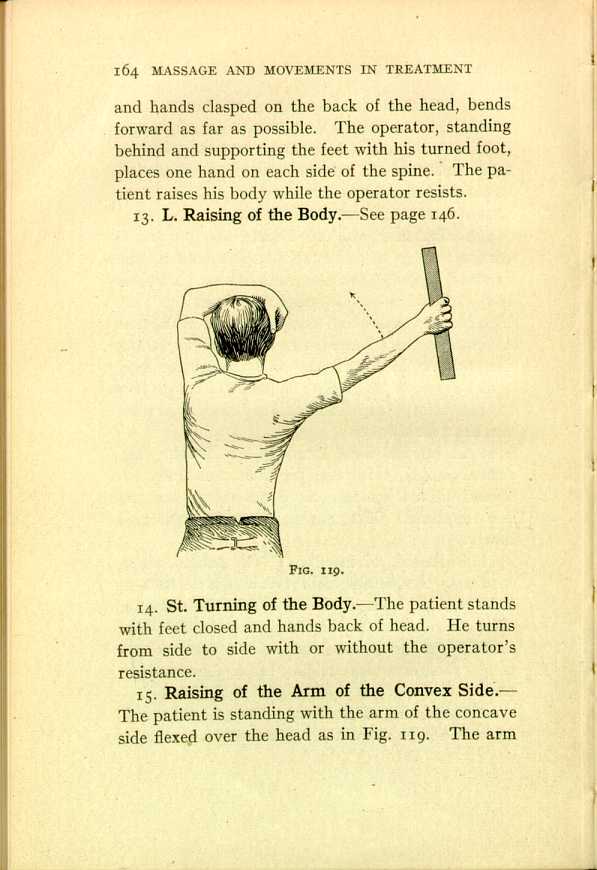
FIG. 119.
[Description: Drawing of a man from the back, with his left arm curved over his head and his right extended to the side. ] - 14. St. Turning of the Body.—The patient stands with feet closed and hands back of head. He turns from side to side with or without the operator's resistance.
- 15. Raising of the Arm of the Convex Side.— The
patient is standing with the arm of the concave side flexed over the
head as in Fig. 119. The arm
of the convex side is raised from the side to the head. A weight is generally used. Careful instructions in regard to respiration should be given.165
- 16. St. Bending of the Knees; Book on Head ("Deep
Knee-Bend''). The hands are placed on the hips with fingers in
front; the patient bends
slowly downward, counting: (1) raising on the tiptoes; (2) bending down as far as possible; (3) resuming tiptoes position; (4) back to original standing position (see Fig. 120). The effort of keeping the body erect in balancing makes this a very useful exercise in the earlier stages of curvatures.
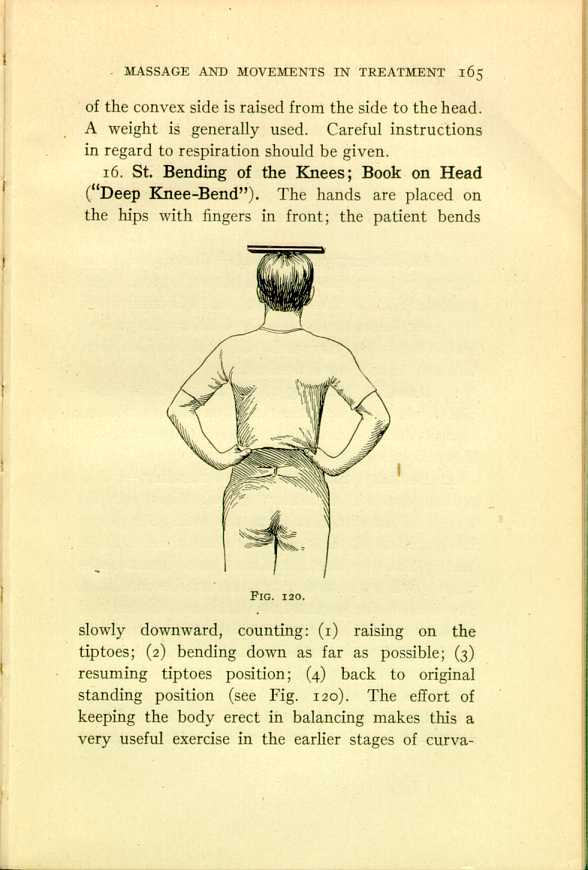
FIG. 120.
[Description: Drawing of a man from the back, balancing a flat object on his head. ]The operator should watch the patient carefully to see that the proper position is maintained from start to finish.166 - 17. Stretch-standing Bending of the knees.— Similar to 16, only the patient stands with his arms stretched upward close to his ears, as shown in Fig. 54
- 18. St. Bending of the Body.—The right (if the convexity is on the right side) foot forward; right hand on hip; left arm raised up and left hand down the back, between the shoulder-blades; the patient should bend slowly forward. Generally single active, but may also be duplicated active.
- 19. Kneeling Bending of the Body.—Same exercise as 18, only the patient rests on the knee of the concave side and places the foot of the convexside forward. Single active.
- 20. Bending Backward; Free-standing.—"The patient stands at a distance somewhat less than the length of his own foot from the wall. He places his hands on his hips with his elbows well thrown back. Then he stretches himself and bends backward. When the movement can not be continued any farther, the patient falls back until the back of his head touches the wall by which he stands. Then he slowly rises up on his toes, and while doing so draws a deep inspiration and goes slowly down again'' (Kellgren).
- 21. St. Bending of the Head Forward and
Backward.—The patient stands with his hands against
the wall and with his feet about twenty inches from the wall; the operator places his hand on the back of the patient's head and resists in the movement. This movement is very effective, and the author suggests that the reader have it applied to himself so as to personally feel its effect upon the different muscles of the back.167
- 22. St. Stretching of the Vertebral Column.— This is a new movement, recommended by the well-known Mr. H. Kellgren, of London. The patient stands as straight as possible; the operator stands in front of him and places one hand on the patient's head, and with the other he steadies him by placing it over the sternum or abdomen; he presses firmly down with the hand on the head, while the patient is told to stretch upward as far as possible. Be careful to see that it does not become only a simple raising of the shoulders. We want a stretching of the whole spinal column.
- 23. Susp. Bending of the Head.—The patient is suspended a few inches from the floor. The operator, standing at his side, places one hand on the forehead, the other on the back of his head. The patient moves the head forward and backward, the operator resisting, according to the strength.
- 24. Susp. Separating and Closing of Legs.— If the
patient is weak, make the movement active at first, while the operator
supports the sides. Afterward make it concentric, the operator grasping
around the ankles.
168
- 25. Susp. Flexion of Legs upon the Abdomen.— The patient is suspended and flexes his extended limbs upon the abdomen. This is a very strong movement and should be used only when the patient's strength allows.
It is very important to watch the patient in regard to his position for each movement. A rest should be given after every exercise, and it may be well to mention that the most complete rest is obtained when the patient lies flat on his abdomen with pillows under chest and stomach. Measure the patient's height; also curvature itself. This is best done by putting the end of the tape-measure on the vertebra corresponding to the extreme point of the convexity; carry it forward over the highest point of the convexity to the sternum or a fixed point of the sternum; then measure the concave side in the same manner and you will know from time to time how your patient improves. Always have a set rule to measure either before or after taking the movements. It becomes the operator's absolute duty to explain to the patient the tedious process of the treatment and the patient's own responsibility in regard to the final result. Exercise should be taken every morning and evening in the patient's own home. The results are remarkably good if proper judgment is used in the selection of movements. This treatment for curvature of the spine is very little known in America, but if given a fair trial, and the movements properly
A few cases of Pott's disease have been treated by the author. Massage of back and chest with respiratory movements were given with good results. Of course it will be understood that there was no inflammatory process going on in the spinal column at the time of treatment. By the use of the pneumauxetor the author fully convinced himself of the increased respiratory capacity. The patients would invariably express themselves as feeling more able to hold the head and thorax erect and the increased respiratory power was always a great relief in this very trying deformity.
SPRAINS
A sprain is a sudden dislocation with a quick replacement of a joint. By the bursting of some smaller veins and lymphatics there is quite an effusion in and around the joint; the sooner that fluid is worked away mechanically the better for the patient. It seems impossible to comprehend that many surgeons still use plaster of Paris casts in the treatment of ordinary sprains, when massage properly applied will effect a cure in a short time.
In sprains it is necessary to begin with slight, careful introductory massage, in the form of centripetal stroking, the pain being very severe. The strength of the manipulation must not be increased
In contraction of the tendo Achillis, turning and rotation of the foot, also flexion and extension, ought to be used after the fifth treatment.
The weakness of the joint after a sprain is frequently relieved by massage, the operator being careful to apply properly the bandage after each séance.
DISLOCATIONS
Inasmuch as "a sprain is a sudden dislocation with a quick replacement of a joint,'' a reduced dislocation is treated very much like an ordinary sprain. Precautions must however be taken to avoid a recurrence until adjoining ligaments, bands and muscles have gained sufficient strength to normally hold the articulation.
For the first few days it is therefore necessary to fix the joint with a bandage, which must be removed daily, when the joint is given a light effleurage and some passive movements to avoid stiffness.
In the course of a few days the bandage can be removed altogether, but the massage treatment must be kept up long after the pain and swelling have subsided.
The initial swelling may be considerably checked and even reduced by the
application of ice bandages,
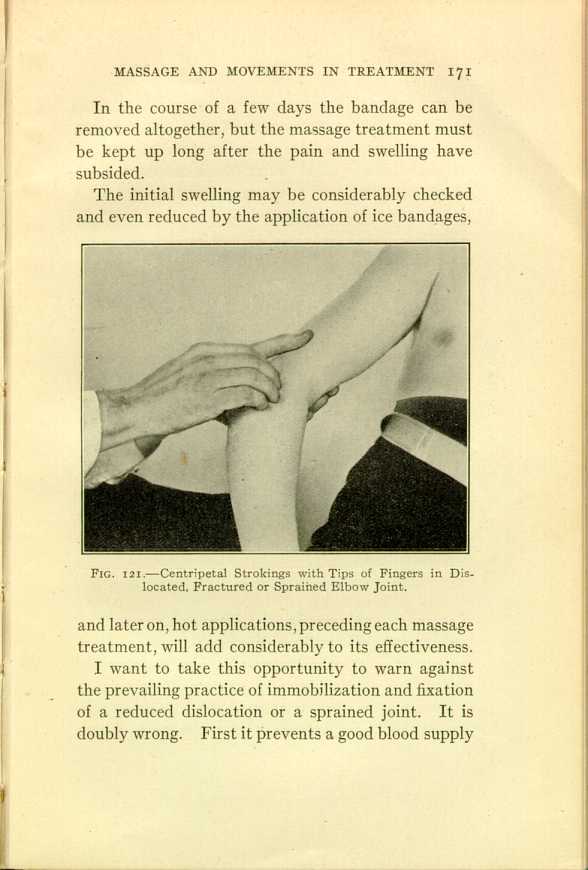
FIG. 121.—Centripetal Strokings with Tips of Fingers in
Dislocated, Fractured or Sprained Elbow Joint.
[Description:
Photograph of an operator's hands stroking a patient's elbow.
]
I want to take this opportunity to warn against the prevailing practice of immobilization and fixation of a reduced dislocation or a sprained joint. It is doubly wrong. First it prevents a good blood supply
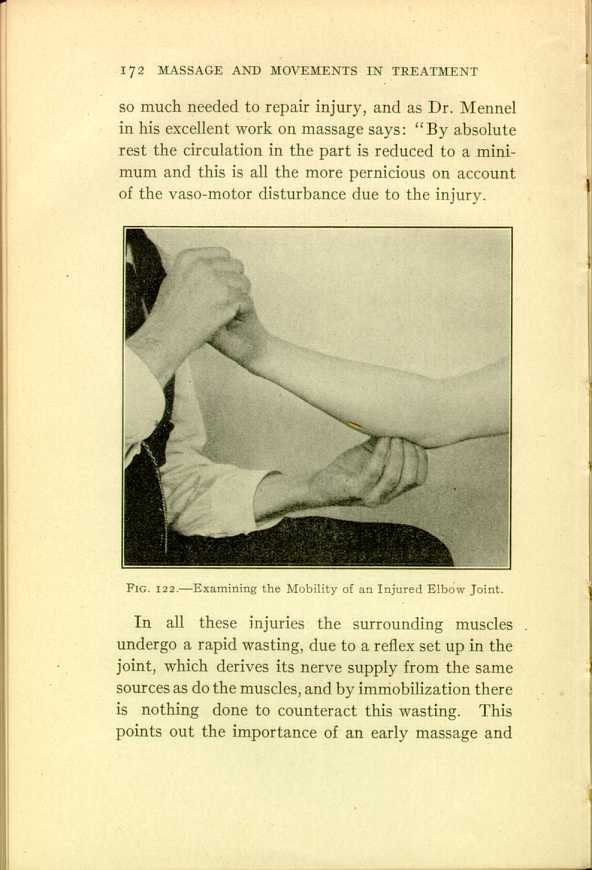
FIG. 122.—Examining the Mobility of an Injured Elbow Joint.
[Description: Photograph of an operator's hands holding a patient's forearm. ]In all these injuries the surrounding muscles undergo a rapid wasting, due to a reflex set up in the joint, which derives its nerve supply from the same sources as do the muscles, and by immobilization there is nothing done to counteract this wasting. This points out the importance of an early massage and
SYNOVITIS
Massage is always indicated in cases of synovitis, so long as there
is no purulent inflammation. The
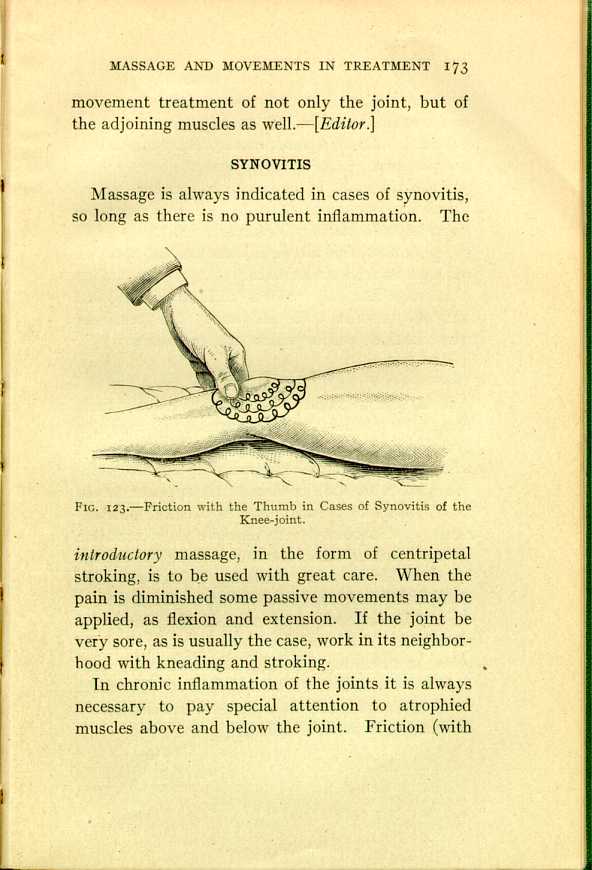
FIG. 123.—Friction with the Thumb in Cases of Synovitis of
the Knee-joint.
[Description:
Drawing of an operator's thumb massaging a patient's knee. Circular
lines indicate movement.
]
In chronic inflammation of the joints it is always necessary to pay special attention to atrophied muscles above and below the joint. Friction (with
In ankylosis always apply very hot water before every séance.
Evald Johnsen, a Scandinavian masseur, out of 137 cases of synovitis, cured 94 perfectly, improved 39 and treated only 4 without any result.
The patient must not be kept in bed, but must use his limbs as much as possible.
Massage not only relieves stiffness of the joint, but also prevents total ankylosis. The treatment must continue not for weeks, but for months.
VARICOSE VEINS
It is best to slightly elevate the affected limb. Start the treatment with massage of the thigh and if the saphenous vein is not seriously inflamed, work with centripetal strokings gently up to the groin. In regard to the local treatment, the operator should avoid too strong pressure directly over the veins affected, but should try to improve the circulation in the collateral veins, thereby relieving the tension in the varicose veins. Stroking is the only safe manipulation directly over the vein, and I always use an oil made of oil of sweet almonds three (3) parts and oil of eucalyptus one (1) part. This oil prevents too strong friction and, besides being antiseptic, seems to have a soothing effect on the patient.
We must remember to use the various circulatory movements of the foot and leg.
We are used to hear persons suffering with this trouble complain about their elastic stockings being so hot and uncomfortable during warm weather. I have used lately with great satisfaction the "Bender Elastic Bandage'' or "Maximum'' bandage of elastic stockings.
In cases of subacute phlebitis we use similar treatment as here described for varicose veins, except that we are safer in using more direct pressure over the veins.
HERNIA
Many cases of recent hernia have been successfully treated by massage. The patient is placed flat on his back without headrest, so as to relax the muscles of the abdomen. We massage the muscles in a general way at first and afterwards locally, the object being to so strengthen the muscular parts around the ring that the normal retentive power is established. I have used with great satisfaction the Iodine Vasogen 7 per cent. with this treatment.
There is no use of trying manual treatment for this trouble unless the patient can be made to fully understand that he is not to stand up without his truss on.
In a severe case a surgical operation is of course necessary for a complete cure. The patient should be instructed in the useful hernia-movements recommended by Dr. George H. Taylor, of New York.
FRACTURES
Since the ambulatory treatment of fractures has been described by Krause in Germany and by Hood and Sir William Bennett, of England, the American surgeons seem to begin to take to it more in a few selected cases.
Every simple fracture of the extremities should be treated by massage before being reduced; we can, by gentle manipulations above and around the fracture, draw the effusions away. The nearer a joint the fracture, the more important the massage becomes. The operator should of course be very careful in handling the injured member and it is necessary to have someone to assist in supporting it.
In fracture of the patella we must take special care of the quadriceps extensor femoris and we must prevent adhesions of the fragments above and below. In giving the massage around the knee we hold the fragments together with the thumb and index finger of one hand and work with the other hand.
In severe fractures with complications treated by the old method the masseur is often called upon to deal with some difficult conditions. Where there is impaired motion from faulty nerve or muscle action the operator should carefully find out which muscles are the weaker and massage them; he should also overcome contractions of the antagonists by movements or splints even, if necessary.
Strokings of the inside of the whole extremity affected are
necessary to restore the circulation. Anyone interested in the
treatment of fractures should read the two following books: "Massage in
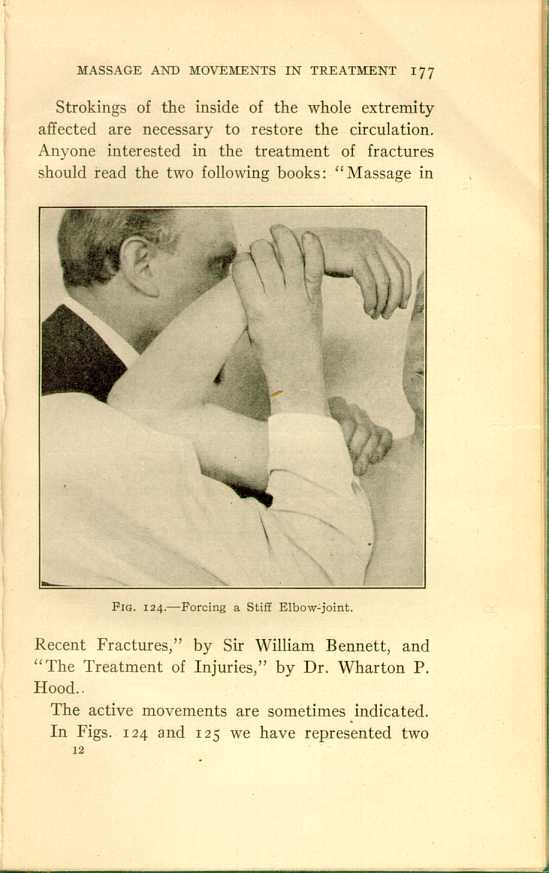
FIG. 124.—Forcing a Stiff Elbow-joint.
[Description:
Photograph of an operator holding a patient's bent arm.
]
The active movements are sometimes indicated.
In Figs. 124 and 125 we have represented two
DEFORMITIES OF THE FEET
In cases of club-foot use massage on the foot and on the leg up to the knee. A few turnings and flexions are very beneficial.
In cases of "pigeon-toes'' use similar treatment as for club-foot, but with the massage extended up to the hip.
Also the following movements:
- 1. St. turning of the leg outward.
- 2. St. rotation of ext. leg (semicircle).
- 3. L. separating and closing of knees.
- 4. Feet at more than right angle, deep knee-bend, operator supporting chest and back.
- 5. Depression and elevation of legs, the operator turning the feet out as much as possible.
- 6. L. separating and closing of legs, feet turned out as much as possible.
In cases of flat foot we can, by the Gefvert splint and our massage and movements, cure the deformity in a comparatively short time, if the patient will only persevere and be willing to stand a little pain. Apply careful massage to the whole foot and leg up to the knee. The following movements are very effective:
- 1. Turning of the foot inward.
179
- 2. Rotation of the foot.
- 3. Flexion and extension of the foot.
- 4. Walking on tiptoe.
- 5. Walking on the outside border of the foot.
- 6. Feet closed; deep knee-bend.
Try to teach the patient to practice walking on his tiptoes five or six
times daily. Massage is a valuable remedy in the complicated local
nerve-troubles, so frequently caused by a condition of talipes valgus.
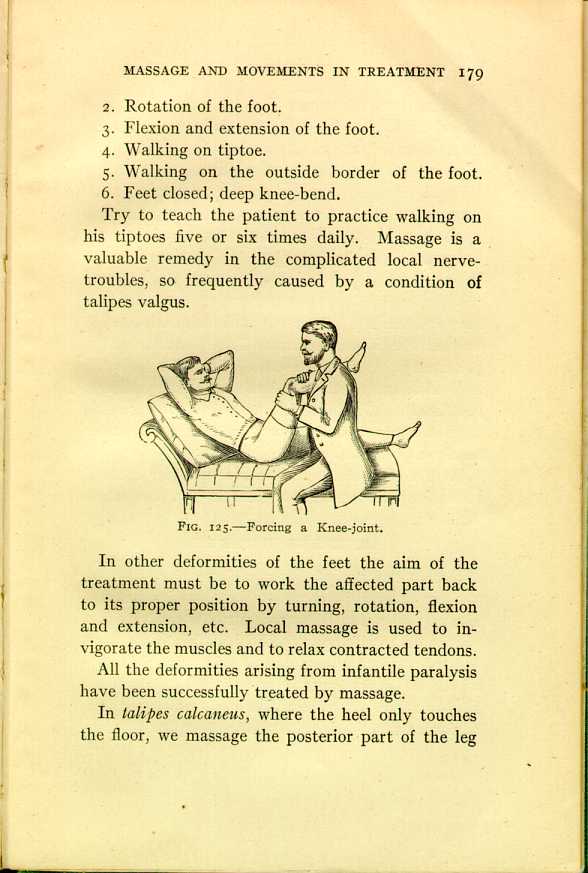
FIG. 125.—Forcing a Knee-joint.
[Description:
Drawing of a patient reclining with his hands behind his head. An
operator sits in front of him, holding the patient's right knee.
]
In other deformities of the feet the aim of the treatment must be to work the affected part back to its proper position by turning, rotation, flexion and extension, etc. Local massage is used to invigorate the muscles and to relax contracted tendons.
All the deformities arising from infantile paralysis have been successfully treated by massage.
In talipes calcaneus, where the heel only touches the floor, we massage the posterior part of the leg
In talipes equino-varus where the toes come to the floor and the heel is drawn up and the foot inverted we massage the tibialis anticus, peroneus tertius and peroneus longus principally. We flex, evert and abduct the foot.
In talipes equino-varus where the toes touch the floor and the heel is drawn up and the foot is everted, we treat the tibialis anticus and the peroneus tertius principally. Our movements should be selected so as to adduct and invert the foot. When you have reached the safe limit of a movement hold the foot in that extreme position for some time to overcome tendinous contraction.
With a good brace and suitable massage there is rarely any real need for operating on the tendo Achillis.
AFFECTIONS OF THE EYE
Ocular massage is being used more every day; we use the second finger mostly but also instruments like corneal spoon, glass rod, etc. We press either on the lid to act upon the lid itself or to act upon the ball by firmer pressure. See Fig. 25. Massage of the lid is used mostly to absorb extravasations in black-eye. The Scandinavian oculists employ ocular massage freely to hasten the complete maturation
Massage is used for several chronic inflammations of the eye. By local massage we increase the circulation around the eye, and act directly upon the cornea. When we desire to see more clearly we rub the eyes, instinct telling us to remove from the cornea such particles as are stagnated. Certain swellings of the eyelids have been treated with great success by massage in the clinics of Schmidt, Rimpler, Rossander and Pagenstecher.
Cases of maculæ corneæ (granules on the cornea) have been very successfully treated. In some cases it is wise to apply massage on the whole front part of the affected side, and also on the same side of the neck.
General massage is frequently used to strengthen the nervous system, thus giving effect upon the optic nerve.
Manual treatment must never be applied to the eye without an order from a physician.
AFFECTIONS OF THE EAR
Some authors (Politzer, Eitelberg) recommend massage for certain affections of the ear, and in my practice I have often been able to relieve severe pain, in cases of otitis, by massage only, in the form of
In a few cases local massage has been applied to the ear with good results (Meyer and Lautenbach). As in chronic congestive headaches, (see page 121), massage of the liver and the cervical and dorsal nerves is of greatest benefit in many ear-conditions. In a case of catarrhal deafness of long standing the author has clearly demonstrated that perfect hearing was restored for several hours after each treatment. Suspending bending of the head, concentric is also of great help, relieving as it does the congestion of the many vessels of the neck. Bending rotation and turning of the head are also useful movements.
| Massage and the Original Swedish Movements | ||
